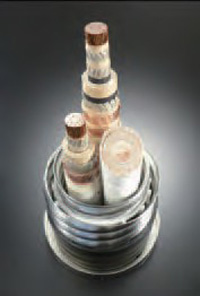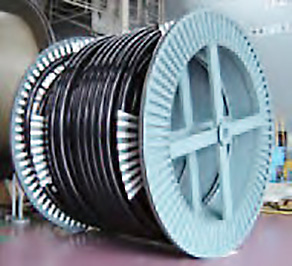Research Results
The Sahara Desert as a power plant for the Earth
High-temperature superconducting cable to cut transmission loss to zero FY2016
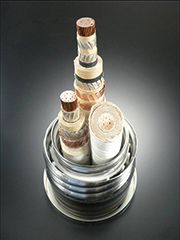
- Sumitomo Electric Industries, Ltd. / late Kazuo Fueki (Emeritus professor, The University of Tokyo) / late Koichi Kitazawa (Emeritus professor, The University of Tokyo) / late Hiroshi Maeda (Emeritus fellow, National Institute for Material Science)
- Development of Creative Technology Seeds, Contract development Manufacturing technology of oxide superconducting material "Bi-based superconducting wire" Developing and implementing Company/Representative Researcher (1991-1996)
- Late Koichi Kitazawa (Emeritus professor, The University of Tokyo)
- CREST
- Phenomena of Extreme Conditions "High-resolution of phase and amplitude of electron waves" Chief Researcher (1995-2000)
- SORST
- "Development and application of high-resolution microscopes for the imaging of phase and amplitude of electron waves" Chief Researcher (2000-2003)
High-temperature superconducting cable enables the transmission of electricity on a global scale
Electrical resistance is a term expressing the difficulty of electricity flow. Generally speaking, all substances possess electrical resistance, and the resistance value increases in proportion to length. This means that whenever electrical power generated by a power plant is delivered to homes or businesses, there are various losses along the way. This transmission loss is understood to be around 5% in modern-day Japan. 5% may seem like a small amount, but over the course of a year this amounts to around 45.807 billion kWh: equivalent to a 100 kWh power plant running at maximum operation for more than 5 years. Cutting this transmission loss to zero would be a major step toward solving many of the world's energy problems.
One answer to this problem is superconducting cable using high-temperature superconductors. Superconductors are specific substances that possess zero electrical resistance when cooled to ultra-low temperatures; if this principle is properly utilized, then electrical cables with very low transmission loss can be constructed.
If we are able to utilize this technology, it might well bring about an electrical revolution on a global scale. The Sahara Solar Breeder Project is a dream project involving construction of a massive solar power system in the Sahara Desert and transmission of the electrical power thus created around the world using high-temperature superconducting cable. It has been calculated that around one-quarter of the Sahara Desert area could provide the world's entire electrical energy needs. If it was possible to transmit electricity over distances of several thousand kilometers, then this is certainly not an impossible dream.
The Sahara Solar Breeder Project
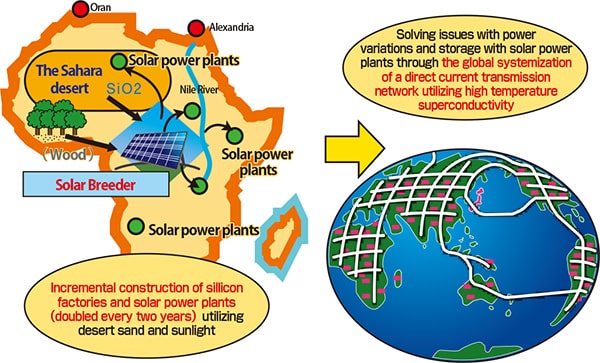
Practical implementation through Contract Developmet
This research into high-temperature superconducting cable was conducted as a collaborative project by Professor Koichi Kitazawa, Professor Kazuo Fueki, Professor Mikio Takano, and Hiroshi Maeda. The research theme was" Manufacturing technology for oxide superconductors (bismuth superconductors), which was adopted by the' Contract Developmet' system in 1990, with Sumitomo Electric Industries, Ltd. assisting the progress of research as the commissioning company.
Bismuth superconductors can sustain a superconductive state at temperatures at least 100°C higher than previously used metal superconductors; however, they are extremely difficult to engineer, and the road to their practical implementation is certainly not an easy one.
Seeking superconductivity at higher temperatures with bismuth cable materials
The temperature at which a superconductive state is entered varies greatly depending on the material in question. Metal superconductors, which were commonly used before the discovery of oxide superconductors, do not enter a superconductive state unless cooled to -269ºC. For this reason, they required the use of extremely expensive liquid helium and thus the high running cost was a problem.
On the other hand, bismuth oxide superconductors enter a superconductive state at -163ºC. It was believed that if the use of comparatively inexpensive liquid nitrogen could be successfully developed instead of liquid helium, costs could be significantly reduced. However, bismuth superconductors are composed of 5 elements in an extremely complex ceramic structure, making them difficult to engineer. They are hard and also brittle. So are most ceramics, generally speaking, and practical implementation of this specific material took over 10 years. The development of a bend- resistant long wire in lengths over 2 kilometers using this hard, brittle ceramic was only achievable with the engineering and manufacturing expertise of Sumitomo Electric Industries, Ltd., one of Japan's leaders in the field. No other team could have implement this technology practically but these researchers and companies working in close collaborate.
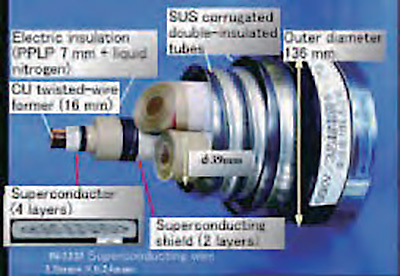
High-temperature superconducting cable (1)
First participation in US government project by Japanese corporation
In 2001, massive blackouts occurred in the state of California, repeating again in 2003 across North America. Many reasons for this failure were given, such as system failure or deterioration of transmission cables, but the surprising thing here is that electrical blackouts, which almost never occur in Japan, are still experienced quite frequently across the USA. In response to this fact, as part of America's energy strategy, a project is underway to construct a power transmission network using superconducting cables across the entire USA by 2030. As part of this project, experiments were conducted on superconducting cable used for electrical transmission in the world's first practical implementation of this technology in the city of Albany, New York.
Sumitomo Electric Industries, Ltd. provided high- temperature superconducting cable developed under the Contract Developmet program, which represented the first participation in a US government project by a Japanese corporation.
In the international joint project, known as the Albany Project, although only 350 meters of superconducting cable was actually laid, it was demonstrated that this would stand up to the rigors of practical implementation. This superconducting cable was installed completely free of trouble, and is capable of continuous unattended operation. In 2012, Japan too commenced its first experimental trials of superconducting power transmission. It seems that this ideal of uniting the world with superconducting cable will soon no longer be a dream, but reality.
High-temperature superconducting cable (2)

